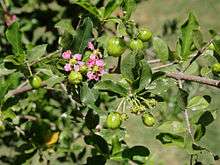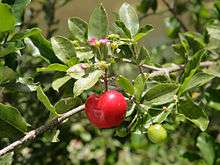Malpighia emarginata
Malpighia emarginata is a tropical fruit-bearing shrub or small tree in the family Malpighiaceae.
Common names include acerola (Spanish pronunciation: [aseˈɾola], Portuguese pronunciation: [ase'rɔla]), Barbados cherry, West Indian cherry[2] and wild crepe myrtle.[3] Acerola is native to South America, southern Mexico, Puerto Rico, Brazil, and Central America, but is now also being grown as far north as Texas and in subtropical areas of Asia, such as India.
It is known for being extremely rich in vitamin C,[4] almost as much as camu camu, although it also contains vitamins A, B1, B2, and B3, as well as carotenoids and bioflavonoids, which provide important nutritive value and have antioxidant uses.[5]
Distribution
M. emarginata is originally from Yucatán, and can be found in Mexico, Central America, the Caribbean, South America as far south as Peru, and the southeast region of Brazil, and in the southernmost parts of the contiguous United States (southern Florida[6] and the Lower Rio Grande Valley of Texas).[6][7][8] In Florida, it can be grown in protected locations as far north as Cape Canaveral.[9] It is cultivated in the tropics and subtropics throughout the world, including the Canary Islands, Ghana, Ethiopia, Madagascar, Zanzibar, Sri Lanka, Taiwan, India, Java, Hawaii, and Australia.[10]
Adaptation
Acerola can be propagated by seed, cutting, or other methods. It prefers dry, sandy soil and full sun, and cannot endure temperatures lower than 30 °F/-1 °C. Because of its shallow roots, it has very low tolerance to winds.
Description

Acerola is an evergreen shrub or small tree with spreading branches on a short trunk. It is usually 2–3 m (6.6–9.8 ft) tall, but sometimes reaches 6 m (20 ft) in height.[11]
Leaves
The leaves are simple ovate-lanceolate, 2–8 cm (0.79–3.15 in) long, 1–4 cm (0.39–1.57 in), and are attached to short petioles. They are opposite, ovate to elliptic-lanceolate, and have entire or undulating margins with small hairs, which can irritate skin.
Flowers
Flowers are bisexual and 1–2 cm (0.39–0.79 in) in diameter. They have five[11] pale to deep pink or red[12] fringed petals, 10 stamens, and six to 10 glands on the calyx. The three to five flowers per inflorescence are sessile or short-peduncled axillary cymes.[11]
Fruit
After three years, trees produce significant numbers of bright red drupes 1–3 cm (0.39–1.18 in) in diameter with a mass of 3–5 g (0.11–0.18 oz). Drupes are in pairs or groups of three, and each contains three triangular seeds. The drupes are juicy and very high in vitamin C (3-46 g/kg)[13] and other nutrients. They are divided into three obscure lobes and are usually acidic to subacidic, giving them a sour taste,[11] but may be sweet if grown well.[14] While the nutrient composition depends on the strain and environmental conditions, the most common components of acerola and their concentration ranges, per 1000 g, are: proteins (2.1-8.0 g), lipids (2.3-8.0 g), carbohydrates (35.7-78 g), calcium (117 mg), phosphorus (171 mg), iron (2.4 mg), pyridoxine (87 mg), riboflavin (0.7 mg), thiamine (0.2 mg), water (906-920 g) and dietary fibre (30 g).[5] Acerola cherries also have anitifungal and antibacterial properties.
Uses
As food
The fruit is edible and widely consumed in the species' native area, and is cultivated elsewhere for its high vitamin C content. About 1677.6 mg of vitamin C are in 100 g of fruit.[2] The fruit can be used to make juices and pulps, vitamin C concentrate,[15] and baby food,[16] among other things.
A comparative analysis of antioxidant potency among a variety of frozen juice pulps was carried out, including the acerola fruit. Among the 11 fruit pulps tested, acerola was the highest-scoring domestic fruit, meaning it had the most antioxidant potency, with a Trolox equivalent antioxidant capacity score of 53.2 mg.[17]
Other uses
Acerola is a popular bonsai subject because of its small leaf, fruit, and fine ramification. It is also grown as an ornamental[18] and for hedges.[10]
It is one of three ingredients in a proprietary herbal medicine for allergic rhinitis.[19]
Acerola is also used in proprietary herbal medicine for herpes.[20]
Ecology
M. emarginata is a host plant for the caterpillars of the white-patched skipper (Chiomara asychis),[21] Florida duskywing (Ephyriades brunneus),[22] and brown-banded skipper (Timochares ruptifasciatus).[23] Larvae of the acerola weevil (Anthonomus macromalus) feed on the fruits, while adults consume young leaves.[24]
References
- ↑ "The Plant List: A Working List of All Plant Species".
- 1 2 Johnson, Paul D. (2003). "Acerola (Malpighia glabra L., M. punicifolia M. emarginata DC.) Agriculture, Production, and Nutrition". In Artemis P. Simopoulos; C. Gopalan. Plants in Human Health and Nutrition Policy. 91. Karger Publishers. pp. 63–74. ISBN 978-3-8055-7554-6.
- ↑ "Malpighia glabra L. wild crapemyrtle". PLANTS Database. United States Department of Agriculture. Retrieved 2009-10-17.
- ↑ "Acerola, (west indian cherry), raw Nutrition Facts & Calories". nutritiondata.self.com. Retrieved 2016-07-18.
- 1 2 Mezadri T, Villaño M, Fernandez-Pachon M, Garcia-Parrilla M, Troncoso A (2008). "Antioxidant compounds and antioxidant activity in acerola(Malpighia emarginata DC.) fruits and derivatives". Journal of Food Composition and Analysis. 21 (4): 282–290. doi:10.1016/j.jfca.2008.02.002.
- 1 2 "Malpighia emarginata DC.". Germplasm Resources Information Network. United States Department of Agriculture. 1998-05-18. Retrieved 2010-02-02.
- ↑ "Malpighia glabra L.". Germplasm Resources Information Network. United States Department of Agriculture. 2007-02-11. Retrieved 2009-12-16.
- ↑ "Barbados Cherry, Mexican Myrtle, Manzanita, Cerez, Huacacote, Wild Crepe Myrtle, Manyonita, Cerezo de Jamaica, Cerezo de Castillo, Pallo de Gallina, Escobillo, Chia, Arrayncito, Xocat, Xocatatl Malpighia glabra". Benny Simpson's Texas Native Shrubs. Texas A&M University. Retrieved 2009-12-15.
- ↑ Boning, Charles (2006). Florida's Best Fruiting Plants: Native and Exotic Trees, Shrubs, and Vines. Sarasota, Florida: Pineapple Press, Inc. p. 41.
- 1 2 Hanelt, Peter (2001). Mansfeld's Encyclopedia of Agricultural and Horticultural Crops (Except Ornamentals). Springer. pp. 1127–1128. ISBN 978-3-540-41017-1.
- 1 2 3 4 "Malpighia glabra L. Malpighiaceae" (PDF). Agroforestree Database 4.0. World Agroforestry Centre. 2009. Retrieved 2009-12-16.
- ↑ National Geographic (2008). Edible: An Illustrated Guide to the World's Food Plants. National Geographic Books. p. 106. ISBN 978-1-4262-0372-5.
- ↑ Vendramini T, Tugo L (2000). "Chemical Composition of acerola fruit (Malpighia punicifolia L.) at three stage of maturity". The Food Chemistry. 71: 195–198. doi:10.1016/s0308-8146(00)00152-7.
- ↑ Nugent, Jeff; Julia Boniface (2004). Permaculture Plants: a Selection (2 ed.). Chelsea Green Publishing. p. 63. ISBN 978-1-85623-029-2.
- ↑ De Assis S, Fernandes F, Martins A, Oliveira O (2008). "Acerola: importance, culture, conditions, production and biochemical aspects". Fruits. 63: 93–101. doi:10.1051/fruits:2007051.
- ↑ Clein N (1956). "Acerola juice—The richest known source of Vitamin C: A clinical study in infants". The Journal of Pediatrics. 48 (2): 140–145. doi:10.1016/s0022-3476(56)80159-5.
- ↑ Kuskoski EM, Asuero AG, Morales MT, Fett R (2006). "Wild fruits and pulps of frozen fruits: antioxidant activity, polyphenols and anthocyanins". Cienc Rural. 36 (4 (July/Aug)).
- ↑ Gillman, Edward F. (October 1999). "Malpighia glabra" (PDF). Cooperative Extension Services Institute of Food and Agricultural Sciences. University of Florida. Archived from the original (PDF) on April 24, 2009. Retrieved 2009-12-16.
- ↑ Corren J, Lemay M, Lin Y, Rozga L, Randolph RK.,"Clinical and biochemical effects of a combination botanical product (ClearGuardTM) for allergy: a pilot randomized double-blind placebo-controlled trial." Nutr J. 2008 Jul 14;7(1):20
- ↑ Sandra Aparecida de Assis, José Carlos Rebuglio Vellosa, Iguatemy Lourenço Brunetti, Najeh Maissar Khalil, Kátia Maria da Silva Cerqueira Leite, Antonio Baldo Geraldo Martins, Olga Maria Mascarenhas de Faria Oliveira, "Antioxidant activity, ascorbic acid and total phenol of exotic fruits occurring in Brazil" International Journal of Food Sciences and Nutrition 2009 60:5 , 439-448
- ↑ "White-patched Skipper Chiomara georgina (Reakirt, 1868)". Butterflies and Moths of North America. Retrieved 2010-03-30.
- ↑ "Florida Duskywing Ephyriades brunnea (Herrich-Schäffer, 1865)". Butterflies and Moths of North America. Retrieved 2010-03-30.
- ↑ "Brown-banded Skipper Timochares ruptifasciata (Plötz, 1884)". Butterflies and Moths of North America. Retrieved 2010-03-30.
- ↑ Ooi, P.A.C.; A. Winotai; Jorge E. Peña (2002). "Pests of Minor Tropical Fruits". In Jorge E. Peña; Jennifer L. Sharp; M. Wysoki. Tropical Fruit Pests and Pollinators: Biology, Economic Importance, Natural Enemies, and Control. CABI. p. 326. ISBN 978-0-85199-434-5.
External links
| Wikimedia Commons has media related to Malpighia emarginata. |
 Data related to Malpighia emarginata at Wikispecies
Data related to Malpighia emarginata at Wikispecies- University of Florida: Acerola
